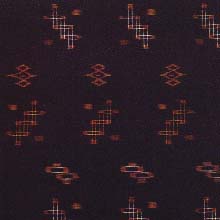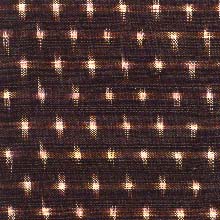Weave (p. 137 )
1. Produced in Nakasatoson(Kume Island) Shimajirigun, Okinawa Prefecture.
2. Characteristics: High quality silk fabric hand woven in "Taka Hata"(high loom) and fulled by block, with hand spun "Tsumugi"(pongee) threads dyed with plant dyes and treated with mud mordanting. It has deep color tone and is soft and gentle. There are 3 kinds: black, white and colored. Designs are stripes, checks, warp-weft Kasuri(splash pattern), weft Kasuri and combined patterns of the above.
3. Uses: Clothing.
4. History: It is surmised that the Kasuri weaving technique originated in India and came to Okinawa in the 14th or 15th century as Okinawa was in trade with Southeastern countries since old days. At the same time, Okinawans developed sericulture in Kume Island, where mulberry grew better than in other islands, producing silk fabric. "Kasuri" fabrics here with the quality of "Chusara"(Okinawan expression meaning "fresh, cool and beautiful") developed into "Kumejima Tsumugi," the oldest Kasuri fabric that gave strong influence upon Kasuri fabrics produced in many districts in mainland Japan. "Kumejima Tsumugi" was originated in the middle of the 15th century when a local man studied sericulture and the spinning technique in China (Ming Dynasty then) and brought them back here. In 1619 a man named Somai Sakamoto in Fukui Prefecture transmitted the techniques of growing mulberry, sericulture and floss silk production by the order of the ruler of Okinawa. And in 1632, a Satsuma warrior (in Kagoshima Prefecture) transmitted the mud dyeing method in Hachijo Island, thus absorbing many techniques. "Kumejima Tsumugi" became one of the first class fabrics in Japan. After the Satsuma invasion in 1609, "Kumejima Tsumugi" was designated as an item for capitation (or poll tax), tax fixed at an equal sum per person. It was shipped to Edo(Tokyo) via Satsuma and became popular by the name of "Ryukyu Tsumugi"(pongee in Okinawa). Specific designs based on those in a designated pattern book were strictly observed for the Tsumugi which was used by the local ruler. The restriction contributed much to the technical development, bringing refined and beautiful fabrics.
Dyeing Method
Dyes come from the plants which grow in the fields and hills in the island. They are "Guru"("Sarutori Ibara," Sumilax china), "Techika" ("Sharinbai," Raphilolepis umbellata), "Kurubo"(Okinawan persimmon, Diospyros kaki), "Yamamomo" (Myrica rubra) and "Yuna" ("Ohamabo," cotton tree). Five basic colors in "Kumejima Tsumugi" are dyed with the 5 dyes above.
(1) Dark brown("Koge cha") is produced by first dyeing the fabric with "Guru" and "Techika" and then mud-dyeing it.
(2) Yellow: First dyed with "Kurubo" and "Yamamomo" and then mordanted with alum.
(3) Reddish brown ("Aka cha"): Dyed with "Guru" and Techika," and then mordanted with alum. (4) Brownish green ("Uguisu"): Dyed with "Kurubo" and "Yamamomo" and then mud-dyed.
(5) Dark gray ("Nezumi"): Dyed with "Yuna" and mordanted with "Gujiru"(juice of ground soy beans).




